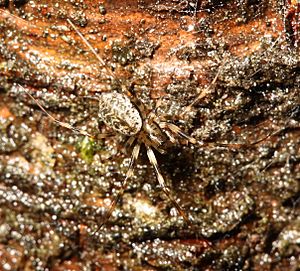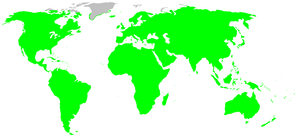Dwarf spiders facts for kids
Quick facts for kids dwarf spiders |
|
|---|---|
 |
|
| Drapetisca alteranda | |
| Scientific classification |
|
| Kingdom: | Animalia |
| Phylum: | Arthropoda |
| Subphylum: | Chelicerata |
| Class: | Arachnida |
| Order: | Araneae |
| Infraorder: | Araneomorphae |
| Superfamily: | Araneoidea |
| Family: | Linyphiidae Blackwall, 1859 |
| Subfamilies | |
|
Dubiaraneinae |
|
| Diversity | |
| 623 genera, 4694 species | |
 |
|
Linyphiidae is a family of very small spiders. There are over 4,600 different kinds (species) in 623 groups (genera) found all over the world. This makes Linyphiidae the second largest family of spiders, right after the Salticidae. Scientists are still finding new kinds of these tiny spiders. For example, a new group called Himalafurca was found in Nepal in 2021. Because these spiders are so small, it can be hard to tell them apart. This often leads to changes in how they are classified.
Spider Names and Groups
Spiders in this family have a few common names. They are often called sheet weavers because of the flat, sheet-like webs they build. In places like the United Kingdom, Ireland, Australia, New Zealand, and Portugal, they are known as money spiders. This name comes from an old superstition. People believed that if one of these tiny spiders ran on you, it meant good luck with money. They thought the spider was spinning you new clothes, which would bring financial good fortune.
This spider family is divided into six main groups called subfamilies. The largest groups are Linyphiinae (the sheetweb spiders), Erigoninae (the dwarf spiders), and Micronetinae. These three groups contain most of the known species.
Some common groups of these spiders include Neriene, Lepthyphantes, Erigone, Eperigone, Bathyphantes, and Troglohyphantes. You can find many of these spiders in cooler parts of the world, but some also live in tropical areas.
The slightly larger members of the Linyphiinae subfamily often build webs that look like bowls or domes. The tiny spiders in the Erigoninae group build very small sheet webs. These tiny spiders, usually less than 3 millimeters long, can often travel through the air by a method called ballooning. This means they can be very common in one area on one day and then disappear the next. Some male dwarf spiders have unique eyes that sit on bumps or stalks, making them look quite unusual.
Here are a few examples of spiders in this family:
- Bowl and doily spider, Frontinella communis
- Filmy dome spider, Neriene radiata
- Blacktailed red sheetweaver, Florinda coccinea
- Orsonwelles, a group of giant Hawaiian sheet weavers. O. malus is the largest known spider in this family.
- Erigone atra, a type of dwarf spider
Where They Live
You can find these spiders almost everywhere in the world. Some species in Norway have even been seen walking on snow when the temperature was as low as -7 °C (19 °F).
Spider Predators
Some birds, like goldcrests, are known to eat money spiders.
Images for kids
See also
 In Spanish: Linyphiidae para niños
In Spanish: Linyphiidae para niños






